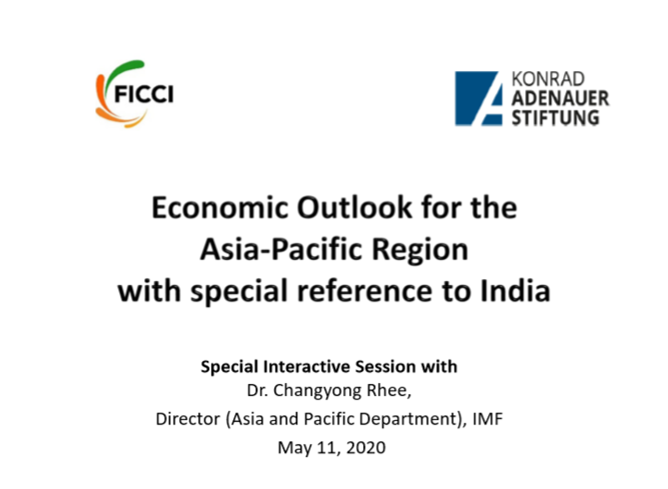The Covid-19 pandemic has been of unparalleled stature. The crisis, which began as a fallout on the health front, in no time has magnified into a full-blown economic crisis. With social distancing being the only plausible solution, the countries have had no option but to undertake lockdowns and seal international borders – brining economic activity to a near standstill.
Amidst the current state of affairs, the Federation of Indian Chambers of Commerce and Industry (FICCI) and the India Office of the Konrad-Adenauer-Stiftung (KAS) jointly conducted a session on ‘Economic Outlook for Asia-Pacific Region with special reference to India’ with experts from the International Monetary Fund to gain better insights into the future of the global economy with emphasis on the Asian economies and India.
Moving forward and beyond global uncertainties, the grimmer growth picture emerging in developed and developing economies is dampening economic recovery prospects despite historically low interest rates.
The challenges for emerging Asian economies are to reinforce the effectiveness of policies, strengthening of local government involvement in disaster resilience initiatives keeping in mind the environmental and climate risks.
The scale of slowdown across countries has been unprecedented and the global economic outlook has been adversely hit. The IMF in its World Economic Outlook announced last month (April 2020) estimated world output to decline by 3.0% in 2020 before noticing a recovery in 2021. Asia, which has been the engine of global growth in recent times – being home to the world’s two fastest growing economies - China & India - is likely to witness zero percent growth in 2020. This, in itself, is unprecedented. Though China has been successful to a large extent in stopping the spread of the pandemic and has initiated economic activity once again, other countries in the region are still struggling to cope with the rising number of cases. While India has been able to limit the pandemic spread curve through stringent lockdown measures, the country’s economic activity has been hit significantly. India is expected to witness negative growth in the year 2020-21 – which will be the first time in about 40 years.
Key Takeaways:
- Asia's growth projected at 0% for the year 2020 which is not only worse than the 4.7% growth rate observed during the Global Financial Crisis but also worse than the 1.3% growth observed during the Asian Financial Crisis in 1997
- Asian economies are performing better than other countries especially advanced countries which have witnessed sharper contractions in their growth forecasts. Slowdown in advanced countries this time is far greater than that witnessed during the Global Financial Crisis
- Chinese economy along with many East Asian economies will be affected by the slowdown in global growth. This is likely to have a strong implication on global trade as well which is expected to decline by 10% in 2020
- IMF in April 2020 forecasted a partial recovery in the global economy starting H2 2020. It also predicted a relatively sharp recovery in 2021 with Asian growth estimated at over 7.0%. However, this is based on the assumption that the government stimulus packages will work to uplift economies and that the virus would peak in the second quarter of 2020
- Governments, economies, individuals and corporations are working collectively to find ways to re-accelerate the economy
- Providing targeted support is critical at the moment
- South Asia has the potential to become one of the growth engines not just for Asia but for the entire world
- Central Banks could use their balance sheets more flexibly to support MSMEs and to help fund the large fiscal expenditure
- While Governments in the short run have to undertake aggressive fiscal policy, it will be very important to have a credible medium-term plan to make the fiscal more sustainable
- A recent survey conducted by FICCI reported that over 70% of the industry participants have been severely impacted by the Covid-19 pandemic and the consequent lockdown. Moreover, almost 68% of the respondents to the survey said they would witness a de-growth in sales in the current year
- A significant impact on consumption as well as manufacturing has been observed in India. Incoming data on high frequency indicators showcases a fairly dramatic hit on the Indian economy during the lockdown phase. Manufacturing and Services PMI numbers have come at record lows
-Though RBI is undertaking longer term repo operations to increase liquidity in those sectors, which have a larger need at the moment including NBFCs and mutual funds, the situation warrants further monetary easing
- Fiscal space in India is extremely limited. However, there is an urgent need to support vulnerable households, healthcare sector and MSME firms
- It is important that India chalks out a detailed and credible fiscal consolidation plan along with announcing any fiscal stimulus. This would soothe concerns of the market and would ultimately help India in borrowing
- Despite weak trade growth observed in March and the country experiencing capital outflows, India enjoys a relatively strong external sector. Lower oil prices would further help manage India’s current account deficit
- In order to strengthen its manufacturing base and utilize its growth potential to full, India needs to rectify various obstacles on the factor market side
- India has a highly regulated labour market which prevents firms from hiring and firing flexibly. While adequate labour protection is necessary, it should not hinder flexibility. Another major constraint for firms in India is in the area of land rights and land acquisition
- Careful assessment of the business environment, including assessing many other small regulations in the country is the need of hour



